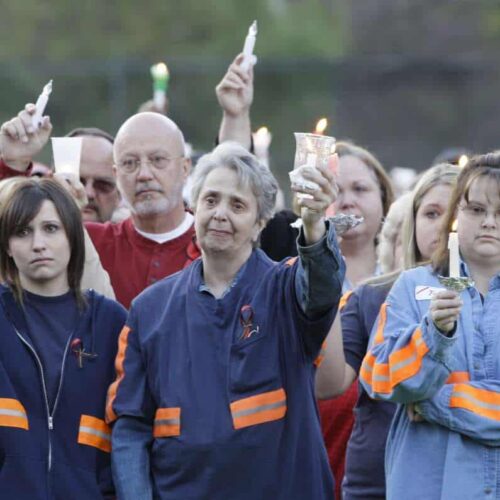Introduction

Autopsies of the 29 men killed in last year’s explosion at the Upper Big Branch coal mine in West Virginia revealed a surprising fact: Most had coal workers’ pneumoconiosis, better known as black lung, a deadly disease that U.S. authorities have been vowing to eradicate for more than 40 years.
The finding is tucked inside a 129-page report released today by an independent panel investigating the mine disaster. Of the 24 miners whose lungs could be examined, 17 had the disease — a rate more than 20 times higher than the average for all underground coal miners.
It wasn’t just the long-time miners working for Massey Energy Co. who had the disease. Some were as young as 25, and five had less than 10 years of experience working in coal mines, according to the report, which largely focused on failures by state and federal regulators and Massey to safeguard miners at Upper Big Branch.
Headlines are sure to focus on the explosion and its causes, but black lung claims many more victims each year — perhaps as many as 10,000 between 1995 and 2005, according to estimates of the National Institute for Occupational Safety and Health, a federal research agency.
The high rate of disease detected in the bodies of the Massey miners “is an alarming finding given the ages and work history of these men,” the report notes on page 32.
In Washington, the latest effort to safeguard the nation’s miners involves a proposal by federal regulators to lower miners’ exposure to dust, the cause of black lung. Public health officials warn that there has been a resurgence of the disease, particularly in central Appalachia, where Upper Big Branch is located.
“There’s no question that there will always be dust in coal mining,” Dr. Edward Petsonk, a physician and professor at West Virginia University, told iWatch News. “But there doesn’t have to be black lung because it is totally preventable.”
A report earlier this year from NIOSH found that, after years of decline, the prevalence of black lung appears to be on the rise, affecting younger miners in many cases.
The federal Mine Safety and Health Administration recently proposed a rule intended to protect miners from dust exposure, but the agency faces resistance from the mining industry, which says the rule wouldn’t be effective and could have grave economic consequences.
10,000 deaths in 10 years
Long a scourge of miners, black lung has no cure. It occurs when coal dust builds up in the lungs. “You can’t walk to the mailbox without losing your breath,” said Randall Hall, a former coal miner who has been fighting the disease for about 20 years. “You cough all night. You can’t play with your grandkids. You can’t do nothing.”

More than 40 years ago, Congress sought to end black lung as part of the 1969 Coal Mine Health and Safety Act. It set standards for the amount of coal dust to which miners could be exposed and created a trust to provide compensation to miners who got black lung.
NIOSH estimates that about 10,000 miners died between 1995 and 2005 from the disease, and the Labor Department estimates it has paid out about $44 billion in benefits since 1970.
Instances of the disease dropped dramatically, but, at some point after 1995, this trend reversed, NIOSH said in its recent report.
What’s more, the increase appears to be occurring among miners who had spent most or all of their working lives in mines that were supposed to be complying with the reduced standard for coal dust exposure stemming from the 1969 safety act.
The disease seems to be a particular problem in central Appalachia, which encompasses southern West Virginia, western Virginia and eastern Kentucky, NIOSH found.
Among possible explanations, according to NIOSH: Many of the more productive coal seams have already been mined, forcing companies to turn to areas containing less coal and more rock. This means the mining equipment grinds up more silica dust, which is potentially more damaging to miners’ lungs than coal dust alone.
Another possible culprit: Longer work hours. Many miners now work 10- or 12-hour shifts and work weekends, leading to greater dust exposure. It is also possible, NIOSH said, that smaller mines, where black lung appears to be particularly prevalent, may lack the resources for dust suppression or the knowledge of the disease and how to prevent its development.
In 2009, MSHA launched an initiative meant to eradicate black lung, and, in October 2010, the agency proposed a rule to limit miners’ exposure to dust. It would cut the current standard in half, require the use of personal dust monitors that provide data instantaneously, impose tougher dust sampling requirements and increase medical monitoring of miners. Current sampling is performed sporadically, and results can take weeks to come back from a lab.
Many mining industry representatives have lined up in opposition to the rule. There is no evidence that the proposed dust standard will protect miners any more than the current one, said Carol Raulston, a spokesperson for the National Mining Association. The industry has argued that the requirement could have serious economic consequences.
Petsonk, a former NIOSH official, said the proposed standard “is based on an impressive body of scientific evidence,” adding, “It’s hard to understand how one could argue that reducing the amount of dust that’s inhaled would not reduce the amount of the disease.”
While the proposed standard would not completely eradicate the disease, he said, it would significantly reduce the number of severe cases.
George Ellis, president of the Pennsylvania Coal Association, said the current standard was “more than adequate.” Asked why cases continue to occur, he said: “There could be other issues besides [coal dust exposure]. It could be age or predisposition; maybe they’re a smoker.”
Industry officials also have raised concerns about the cost of the proposed rule. Complying with the new standard could require changes to mine layout, equipment upgrades and purchase of expensive new monitors, some have argued.
“If you’re going to make a big portion of underground coal mining uneconomic, what does that do for employment and meeting the nation’s energy needs?” Raulston said. In comments submitted to MSHA, some worried that the rule might lead to shuttering of smaller mines.
MSHA refused to comment, even generally on black lung and its efforts, citing the ongoing rulemaking.
‘There are solutions’
At Upper Big Branch, only one of the 17 miners found to have black lung started working in the mines before the current standard for coal dust exposure was in place, the independent investigation report found.
“This was an exposure limit that was believed at the time sufficient to prevent black lung disease,” the report noted, echoing the recent NIOSH report. “It has since been determined ineffective to protecting miners’ health.”
Like the Upper Big Branch victims, Robert Compton should never, in theory, have been exposed to more than two milligrams per cubic meter of coal dust — the allowable standard. Yet he, too, developed black lung.
After serving as a medic in the Army, Compton went to work in the coal mines of eastern Kentucky starting in 1974. He was among the first into a new section of the mine, making sure the roof was supported and wouldn’t cave in. “Sometimes it’d get so dusty you couldn’t see your hands and face,” he said.
It was 1992 when doctors discovered signs of the first stages of black lung, but he continued working. Finally, in 2008, doctors advised him to stop.
“On account of my lungs,” he said. “They told me my kidneys were about to give out, too.”
Now he can’t walk far before he’s out of breath, and the coughing fits can be rough. He has multiple inhalers and a machine that delivers breathing treatments through a mouthpiece.
“The doctor already told me one day that’s what’s going to take me out of this world,” he said.
Like most other miners seeking compensation for their illness, Compton had to file a claim with the Labor Department. A 2009 report by the Government Accountability Office, the investigative arm of Congress, found that miners often don’t have access to the legal or medical resources they’d need to demonstrate that they have the disease and that it was caused by their work exposure.
West Virginia lawyer Tim Bailey takes a different approach, using a state law to sue coal companies in some black lung cases.
“It’s the only type of case I’ve ever had where pretty much everyone acknowledges that the coal companies cheat,” Bailey said. “It’s out-and-out criminal.”
Just as the independent investigation of Upper Big Branch found that following basic safety practices could have prevented the explosion, similar adherence to common practices could greatly reduce dust exposure, Petsonk said.
“There are solutions within the existing technology,” he said. “It’s just a question of resources and will.”
Read more in Environment
Environment
EPA agrees to reveal secret identities of potentially risky chemicals
While government opens a window, industry fears disclosure to competitors
Environment
The Bay State’s toxic legacy
Massachusetts still struggling with Superfund sites despite expenditure of millions in cleanup costs



Join the conversation
Show Comments